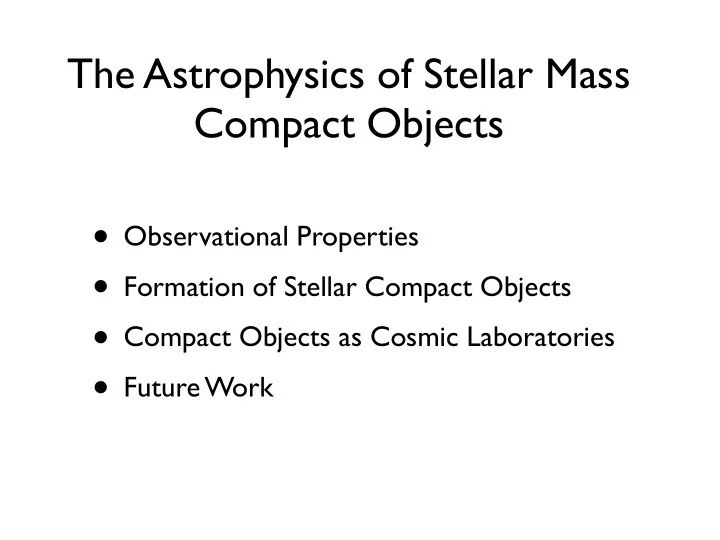

The Astrophysics of Stellar Mass Compact Objects • Observational Properties • Formation of Stellar Compact Objects • Compact Objects as Cosmic Laboratories • Future Work
GALACTIC CENTER IN X-RAYS Wang et al
Main Categories of Compact Binary Systems • Stellar Binary X-ray Sources (Black Holes/ Neutron Stars with a Companion) • Cataclysmic Variables (White Dwarf with a Companion) • Binary Radio Pulsars (Neutron Star/Neutron Star or Neutron Star/White Dwarf Star)
MAIN CLASSES OF X-RAY BINARY SOURCES HMXB LMXB X-ray Spectra Hard (>10 keV) Soft (<10 keV) High B field NS Low B field NS Accreting Star or BH or BH Accretion Roche lobe Wind Process overflow Companion Star High Mass Low Mass
Binary Evolution - Roche Geometry
Examples of Typical Binary X-ray Sources
J1650-500 J1859+226 GX 339-4 BW Cir GRS1915+105 V404 CYG J1819-254 J1655-40 J1550-564 4U1543-47 H1705-25 GS1124-684 GS2000+25 A0620-00 GRS1009-45 J0422+320 J1118+480 LMC X-3 LMC X-1 CYG X-1 Casares
ENERGY EFFICIENCIES GM/Rc 2 Star Radius (km) Sun 700,000 0.000002 White Dwarf 10,000 0.0002 Neutron Star 10 0.15 Black Hole >3 0.1 - 0.4
Formation of Compact Objects 5 Black hole 4 Compact object mass � M � � 3 Tentative limit White dwarf 2 Electron capture supernova NS 1 Regular NS 0 5 7.5 10 12.5 15 17.5 20 22.5 Initial star mass � M � �
Counter example: Westerlund 1 • Young stellar cluster ~ 3-5 Myr with a turnoff mass ~ 35 solar masses • Existence of a slowly rotating neutron star: CXO J164710.2-455216 (10.6 s) radiating at a luminosity of ~ solar luminosity in X-rays • Very high observed fraction of binaries (~70%) amongst the high mass population
Compact Objects as Cosmic Laboratories • X-ray Transients - Neutron Stars • X-ray Transients - Black Holes
X-ray Transients - Neutron Stars • X-ray variability correlates with mass transfer rate: H/He disk stability model predicts various states • X-ray bursts (active and quiescent states)
Campana et al
Constraints on Dense Matter • Equation of state: radius constraints from fitting model atmospheres (flux, temperature, and distance must be known); gravitational redshift; mass and its maximum value • Thermal state of neutron stars
EXO 1745-248 Ozel et al
RADIO PULSAR DIAGRAM
• Mass measurements of pulsars J 1614-2230 (Demorest et al 2010) and J 0348+ 0432 (Antoniadis et al. 2013) yield masses of 1.97 and 2.01 solar masses respectively with uncertainties of 0.04 solar masses • Rules out most condensate, hyperon, and quark models
Case Study: SAX 1808.4-3658 • First accreting millisecond pulsar discovered (2.5 ms) • Regular outbursts ~ 2 years • Distance ~3.4-3.6 kpc, implying mean mass transfer rate is known
• Prediction on quiescent flux • X-ray spectrum during quiescent state is well fit by a power law without a black body component (kT < 35 eV) L NS < 10 31 ergs / s
Heinke et al
X-ray Transients - Black Holes • High luminosity states characterized by a soft thermal component • Low luminosity states characterized by power law with photon index ~1.7 • Hard states with the presence of cool gas: soft thermal and reflection component; evidence of iron features
X-ray properties Spectra � Timing � States �
Ultra-luminous X-ray Sources • very soft spectra (< 0.2 keV) • luminous ∼ 10 39 − 10 42 ergs / s • stellar mass black holes accreting super critically? • intermediate mass black holes (100 - 1000 solar masses) accreting sub critically?
Miller et al
X-ray Transients - Black Hole Spin • Thermal continuum spectrum from the accretion disk • Broad and skewed fluorescent iron line emission from the disk • High frequency quasi-periodic oscillations (trapped g-modes, parametric resonances, Lense-Thirring precession)
Shafee et al
Summary of Spin Estimates Source M a/M A0620-00 6.3-6.9 0.13-0.44 LMC X-3 5.9-9.2 0.09-0.38 J1550-564 8.5-9.7 0.06-0.54 J1655-40 6.0-6.6 0.65-0.75 4U1543-47 8.4-10.4 0.79-0.89 M33 X-7 14.2-17.1 0.81-0.89 LMC X-1 9.4-12.4 0.85-0.97 Cyg X-1 13.8-15.8 > 0.98 1915+105 10-18 > 0.98
Fragos et al
Relativistic Fe line profiles
XTE J1550 ! 564 GRO J1655 ! 40 Cygnus X ! 1 GRS 1915+105 Miller
High frequency quasi periodic oscillations Remillard et al
Future Studies • Probes of dense matter through neutron star properties • Formation and evolution of black holes in different systems and environments • Disk physics - investigation of turbulent viscosity & resistivity: importance for disk structure and its variability especially the inner region
Recommend
More recommend